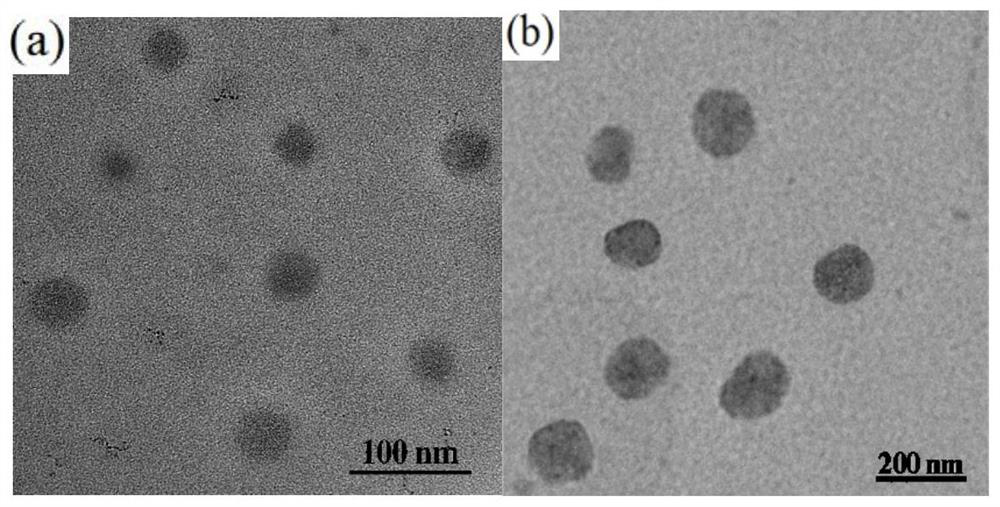Multifunctional liposome based on hydrogen peroxide response and its preparation method and application
A technology of hydrogen peroxide and liposome, which is applied in the field of nanomaterials, can solve the problems of lack of application of nanometer drug-carrying systems, achieve the effects of optimizing imaging capabilities and drug treatment effects, prolonging circulation time, and avoiding decomposition
- Summary
- Abstract
- Description
- Claims
- Application Information
AI Technical Summary
Problems solved by technology
Method used
Image
Examples
Embodiment 1
[0042] Embodiment 1: the synthesis of PEG-PPS amphiphilic polymer
[0043] Add 50mL of anhydrous chloroform into a 100mL round bottom flask, weigh 7.50g of mPEG 2000 dissolve in it. Place in an ice-salt bath, add 0.80 mL of triethylamine, 45 mg of DMAP and 1.00 g of p-toluenesulfonyl chloride and stir for 5 min. Then the reaction device was placed at room temperature for 20 h. After the reaction, the product was concentrated by evaporation and precipitated with 500 mL of diethyl ether. After filtration, it was dried in a vacuum oven for 48 hours and then weighed to obtain 6.48 g of the product. Weigh 5.00 g of the above product and dissolve it in 12 mL of methanol, and add 3.42 g of potassium thioacetate and 16 mL of triethylamine to react for 36 h. After the reaction was completed, the solid was re-dissolved uniformly in chloroform, extracted with saturated sodium bicarbonate and sodium chloride solution, and finally dried with anhydrous magnesium sulfate for 24 hours. A...
Embodiment 2
[0044] Embodiment 2: Preparation of PtdSer@PEG-PPS nanoliposomes
[0045] Accurately weigh 20 mg of phosphatidylserine and 5 mg of PEG-PPS in an eggplant-shaped flask containing 5 mL of chloroform, and remove the organic solvent by rotary evaporation at 40 °C to form a thin film at the bottom of the flask. After drying in a vacuum oven for 12 hours, add 10 mL of PBS buffer solution with pH=7.4, shake and hydrate at 55°C for 45 minutes, and then filter through a 0.45 μm, 0.μm22 microporous membrane to obtain the bimodal probe lipid body.
Embodiment 3
[0046] Example 3: FITC-SiO 2 @Fe 3 o 4 Preparation of (FSF) bimodal probes
[0047] Put 12 mL of absolute ethanol and 50 μL of 3-aminopropyltriethylsilane in a 100 mL round bottom flask, and dissolve 10 mg of FITC into the above solution, and dissolve under ultrasonic conditions for 10 min. Mix 15mL of deionized water, 80mL of absolute ethanol, and 1mL of 25% ammonia water in a 250mL round bottom flask, and 20mg of SiO 2 @Fe 3 o 4 Nanoparticles were added into it, and mechanically stirred in a dark place after being uniformly dispersed, and 1 mL of tetraethyl orthosilicate was added thereto, and then the pre-prepared FITC solution was slowly added dropwise, and reacted for 10 h after the dropwise addition was completed. After the reaction, separated by a strong magnetic field, washed several times with distilled water and absolute ethanol, and dried in a vacuum oven for 3 days to obtain FITC-SiO2@Fe3O4(FSF). figure 2 Mid-infrared characterization demonstrates the succes...
PUM
 Login to View More
Login to View More Abstract
Description
Claims
Application Information
 Login to View More
Login to View More - R&D
- Intellectual Property
- Life Sciences
- Materials
- Tech Scout
- Unparalleled Data Quality
- Higher Quality Content
- 60% Fewer Hallucinations
Browse by: Latest US Patents, China's latest patents, Technical Efficacy Thesaurus, Application Domain, Technology Topic, Popular Technical Reports.
© 2025 PatSnap. All rights reserved.Legal|Privacy policy|Modern Slavery Act Transparency Statement|Sitemap|About US| Contact US: help@patsnap.com



